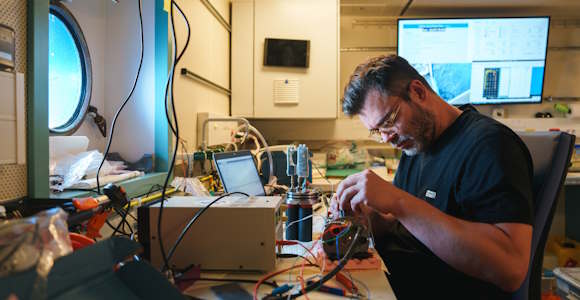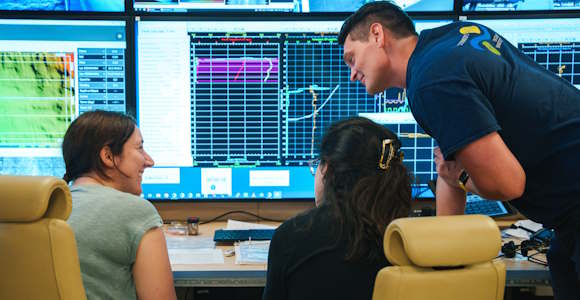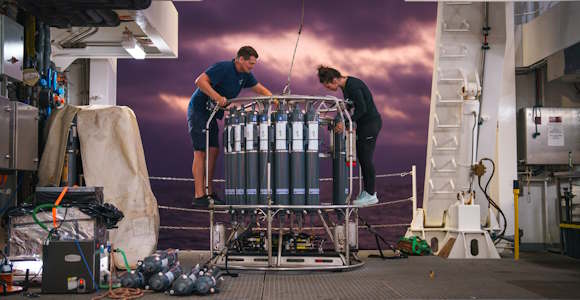
Scientists Discover Oxygen in Ocean areas where no Oxygen has Previously been Found
Oxygen is vital for most life forms. So, it draws attention when a new technique, developed at SDU, finds tiny concentrations of oxygen in the Southeast Pacific, where oxygen has never been detected before.
Large portions of the world's oceans contain so little oxygen that neither fish nor whales can live there. These areas, called Oxygen Minimum Zones, occur naturally in several places.
The largest of them stretches thousands of kilometers along the Pacific coast of North and South America and now, an SDU research team has been on an expedition to explore the unique oxygen depleted environment in the southeastern part.
The expedition also included a new device to measure the water's oxygen content, developed by biologists Morten Larsen and Bo Thamdrup from the Department of Biology in collaboration with Laura Bristow from the University of Gothenburg.

Ocean areas without oxygen
These naturally occurring regions are known as Oxygen Minimum Zones (OMZ). In these areas, standard equipment cannot detect any oxygen at depths of 100-1000 meters
The new device, named the mini Trace Analyzer In situ Logger (mTail), can detect much lower oxygen concentrations than traditional equipment used for this purpose.
- We used it on the expedition to the Southeast Pacific Oxygen Minimum, where no oxygen had been detected before. But with the new device, we found tiny concentrations of oxygen in several parts of the water column that had never been recorded before, says Morten Larsen, biologist and research engineer, Department of Biology.
Although the detected oxygen concentrations are very small, their discovery could completely change our understanding of what occurs in the large Oxygen Minimum Zones.

- Since no oxygen had been detected before, researchers assumed that the microorganisms in these zones could manage without oxygen, using for instance nitrate instead, says marine biologist and associate professor at the Department of Biology, Beate Kraft, who also participated in the expedition.
It matters whether the microorganisms use oxygen, nitrate, or entirely different substances to sustain life. These microorganisms exist in such enormous numbers that their activity significantly influences Earth's vital processes and, consequently, how many greenhouse gases escape from the ocean into the atmosphere.
- For example, a microorganism that consumes nitrate can produce nitrous oxide, a greenhouse gas 245 times stronger than CO2. Therefore, it matters for Earth's climate whether one or the other type of microorganism lives in the large oxygen-free zones in the oceans, says Beate Kraft.
The scientific expedition
Researchers from Denmark, Chile, Spain, Mexico, England, and Sweden participated in the 34-day expedition to the Southeast Pacific Oxygen Minimum Zone aboard the vessel R/V Falkor (too), operated by the Schmidt Ocean Institute. From SDU, biologists Beate Kraft, Morten Larsen, and Elisa Hernández Magaña took part.
- With this new knowledge, we must account for oxygen-consuming microorganisms in the zones, which could alter our understanding of the dynamics driving the emission of greenhouse gases from them, explains Elisa Hernandez-Magaña, postdoc at Department of Biology.
She and Beate Kraft study, among other things, the microorganism Nitrosopumilus maritimus, which is not a bacterium but an archaeon. Archaea are as small as bacteria but as different from them as humans are, having their own branch on the tree of life.
Nitrosopumilus maritimus is known for consuming ammonia and thus a microorganism that produces the potent greenhouse gas nitrous oxide for the atmosphere. However, it does need oxygen for this process, and it has been a longstanding puzzle why these archaea are also very abundant in waters where no oxygen was found.

Previous research by Beate Kraft and colleagues has offered an explanation: Nitrosopumilus maritimus has an unexpected ability to produce tiny amounts of oxygen, which it consumes itself when living in oxygen-free water.
“The question then is whether they consume oxygen when it is present in the ocean water, or if they produce the small amounts of oxygen they need while simultaneously producing the potent nitrous oxide for the atmosphere”, says Beate Kraft.
Ammonia-oxidizing archaea like Nitrosopumilus maritimus are extremely widespread in seawater worldwide, so its behavior affects the atmosphere's greenhouse gas content - depending on what it consumes and produces.
Meet the researcher
Morten Larsen is a biologist and research engineer at the Department of Biology developing underwater robotics and an expert in optical trace oxygen sensors.
Meet the researcher
Beate Kraft is an Associate Professor at Department of Biology. Her research is focused on microbial physiology and biochemistry and supported by Carlsbergfondet, Villum Fonden and The Human Frontier Science Program.
Meet the researcher
Elisa Hernández-Magaña is a postdoctoral researcher at the Department of Biology, where she also earned her PhD. Specializing in microbial ecology, her work focuses on the physiology of microbes exposed to oxygen depletion.